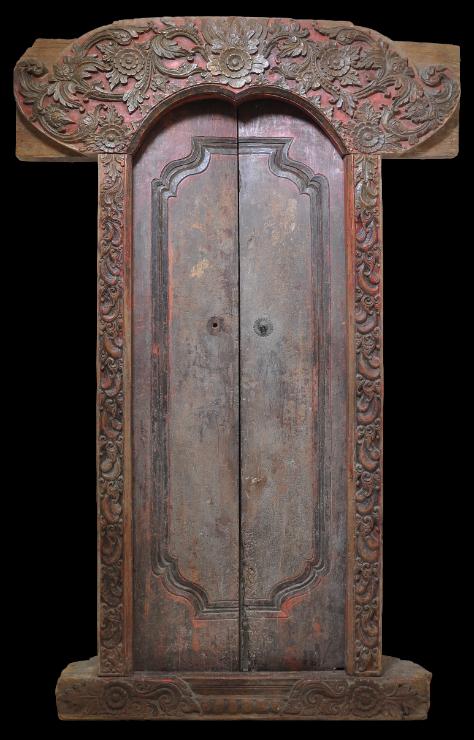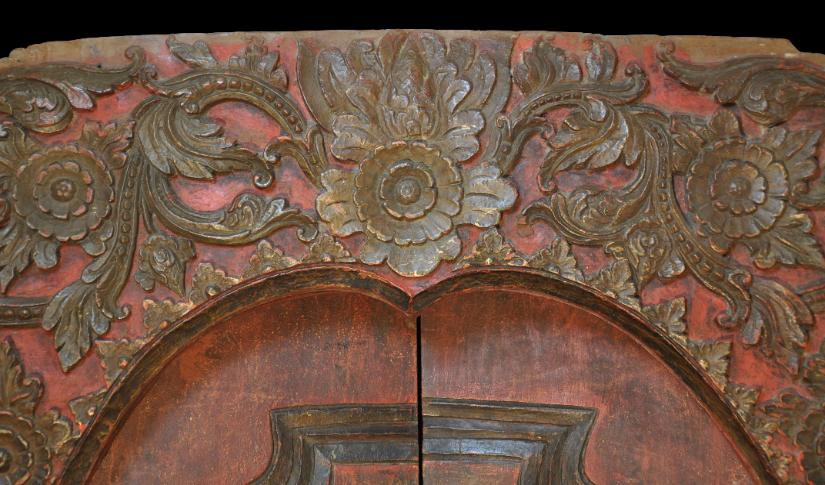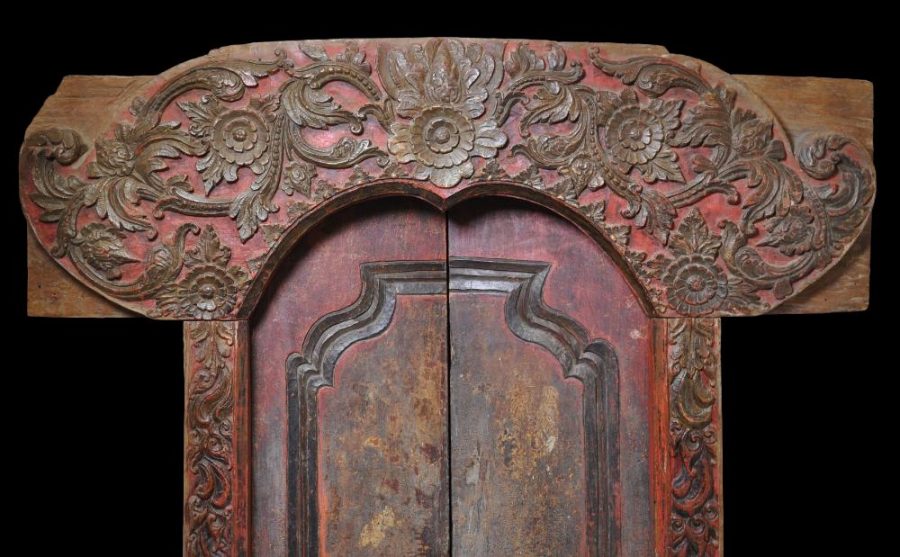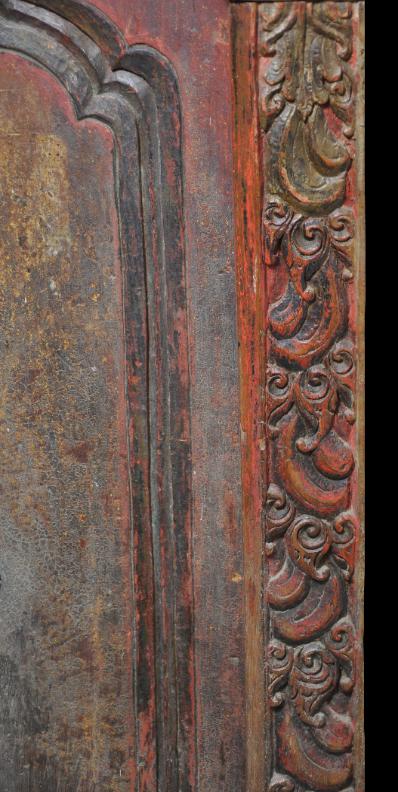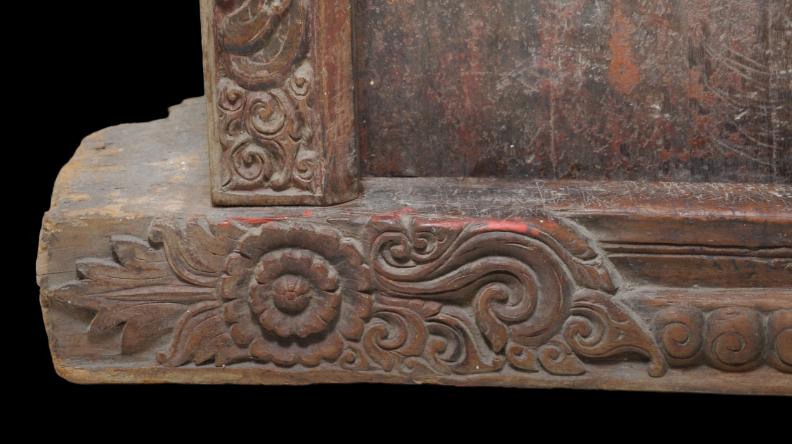Enquiry about object: 3575
Superb Balinese Palace Door & Frame
Bali, Indonesia 18th-early 19th century
height: 178cm, width: 110cm
Provenance
private collection, Ireland.
This stately door of two leaves and a frame is from Bali. It dates to the 18th century and possibly to the early 19th century.
According to Carpenter (2016), this door is a classical example of the portals used in prominent Balinese pavilions (bale) within the palaces (pura) of Balinese royalty. Possibly it is from one of the places in the vicinity of Singaraja, the capital of Buleleng, a once powerful and prosperous kingdom founded in the 17th century, which once ruled all of north and west Bali. The Dutch conquered the forces of the Raja of Singaraja in 1843 and it is possible that this event lead to the door leaving Bali (the door’s immediate source is a private collection in Ireland.) Ibbitson Jessup (1990, p. 242) cites another door now in Denpasar’s Museum Bali which is from a palace in Singaraja which is believed to have been obtained by the Dutch at this time. But a more southern provenance is possible too. The door here is less exuberant, and shows less ‘busy’ Chinese influence than might be expected for a door from the more trade-oriented north, and so might be from another of Bali’s mini-kingdoms or regencies.
The somewhat low height of the door and frame is in keeping with the relatively small stature of the Balinese, particularly in the 18th century. Indeed, it is in keeping with the relatively low heights of most people in the 18th century. When the Dutch and other Europeans first came to what was to become the Dutch East Indies, rarely, if ever, do written accounts comment on the small physical stature of the locals, because at that time, with their poor nutrition, Europeans were scarcely much taller.
The curved upper shape of the lintel (ambang) with flaring curls on either end are a wooden variation of those seen in historical stone and brick temples dating back to the 8th-9th centuries. The door consists of two rectangular leaves that swing inwards. These are undecorated except for a double line lozenge shape. As throughout Indonesia the hinge system consists of round pegs which are part of the door leaves. These extend beyond the perimeter of the door and fit into round holes carved into the lintel and threshold or doorstep. It would have been mortared into the wall thus the beams extending beyond the frame and the uncarved part of the lintel would not have been visible (Carpenter, 2016).
The surfaces of the lintel, side frame and doorstep are elaborately carved in high relief, the latter with a floral meander featuring stylised lotus flowers (padma) and elaborate leaves which are most likely a result of the merger of a Javanese Hindu-Buddhist motif and the acanthus leaf. The latter is known as the karang Belanda, literally ‘the Dutch motif’, and is inspired by the acanthus leaf pattern seen on Dutch Baroque furnishings (Carpenter, 2016). The scrolling floral motifs also are in keeping with a Malay-Islamic aesthetic.
Part of the decoration comprises scrolling stems with what might be described as a pea or an open seed pod motif. This motif first featured in European jewellery in the early 17th century and itself might well be suggestive of early European influence.
The central lotus, which has replaced the usual kala or boma guardian monster mask seen above the portals most Balinese temples, is surrounded by a bundle of leaves and flanked by two blossoms. Four other open lotus flowers, two on each side, create a harmony.
The styling of the central lotus motif is reminiscent of kala or kurtimukha masks used above temple doorways in South India, which now doubt is the inspiration for the configuration here. Reichle (2010, p. 296) says that in Balinese cosmology, the padma or lotus is a symbol for the centre of the universe, so it is fitting that it should be the centre of the door top rail, lording over the boundary between the inner and the outer.
The front section of the door step is carved with a row of circular karang batu or rock motifs. This motif is often seen on old examples of Balinese carved wooden items on that part which is nearest the ground.
Like most palace doors, these were once elaborately painted as well as carved. The dominant colour is a deep red made using cinnabar, an expensive pigment imported from China, which was often used by the Balinese. There are also traces of gold leaf and yellow paint, which was probably used as a substitute for gold leaf, and green. The traces of yellow paint are suggestive of the door’s royal associations – yellow is the colour of royalty in Southeast Asia.
There is evidence of several coats of paint. This is not unusual, as the wooden parts of palaces and temples occasionally were re-painted for important festivals and celebrations. Multiple layers of paint suggest the doors’ age.
The doors and frame have a superb patina and plenty of wear in appropriate places. The doorstep or threshold has been worn thin by the passage of feet over many years. The lower parts of the door leaves also show evidence of having been scuffed by countless feet.
According to Reichle (p. 167), gateways are integral to the division of space in Balinese architecture. Almost all Balinese buildings – temples, palaces and household compounds – comprise a series of courtyards separated by wall and by function. Temples, for example, are divided between outer and inner courtyards; between sacred spaces and the more secular. Temples are places where humans, gods and ancestors meet; and on festival days, the Balinese viewpoint is that the traffic of beings, supernatural and otherwise, can be immense. Mrazek (1989, p. 81) illustrates a related set of doors and says that they provided a divide between a raja’s or prince’s quarters and the outside, providing a ‘magically charged threshold between safety and a demonic ‘outside’.’
Arguably, the most important remaining temple or palace doors that still stand in Bali today is the Great Door of the palace in Klungkung, the Puri Agung Semarapura. The Door is all that remains of the palace from which the Raja of Karangasem, Dewa Agung Jambe II, and members of his family and court emerged on April 18, 1908, to face colonial Dutch gun fire, in a ritual suicide known as a puputan. According to Wiener (1995, p. 359), the Door remains a potent reminder of the power of Klungkung’s kings. The forecourt before the Door appears empty but Balinese consider it to be teaming with the spirits of the invisible world.
Other than wear from the door’s original use as an entrance, there is some minor and old worm damage to the extremities which is barely visible from the front, and there is only one very small and barely perceptible area of loss to the carving. Each of the doors was fitted with a circular metal latch plate. One of these is now missing from one of the doors.
As is typical of all such traditional Balinese doors, the door de-constructs into the six separate pieces: the threshold, two jambs or side rails, the top rail, and two door leaves. This aids with shipping and storage. The door can be assembled with ease. The original slots carved into each wooden piece are still functional and the set fits together easily and in a stable fashion (no metal is used). The set is not free-standing; it is best if it leans against a wall or some other surface to support it. The set is most probably carved from jackfruit (nangka) wood (Artocarpus heterophyllus – a non-CITES species.)
The door is sculpturally very imposing. The carving is beautiful, and the patina is superb. Its graceful, stately style shown belongs to an earlier period of Balinese art and architecture, which is both powerful and understated. According to Carpenter (2016), most such doors were replaced by the Balinese as the various pavilions fell into disrepair, and were sold to foreign visitors from the early 1930s onwards. They are now extremely rare on the island. The door here stands out in contrast to more elaborate modern versions which tend to have overly profuse decoration, excessive gilding and perhaps overt Chinese influence with little or no obvious patina and age.
It has come from a private collection in Ireland. The set seems to have been in Ireland for so long that its origins had become obscured; the previous owners had thought that the doors were Indian. It is likely that the door came to Europe during the age of steamship travel. The emergence of steam travel between Asia and Europe occurred around 1870. Steamships were bigger and faster and had much greater capacity to carry cargo. It is around this time onwards (until the advent of air passenger travel) that passengers suddenly were able to bring large items back to Europe collected on their travels. The opening of the Suez canal on 1869 further encouraged this trend which allowed travel by steamship to be faster and cheaper.Baird, C., ‘Captain Thomson’s letter: A discussion on ‘China Trade’ furniture with particular reference to the port of Singapore’, Furniture History, Vol. 45, 2009.
The last image shows the Great Door of the Puri Agung Semarapurar Palace, Klungkung, Bali (photographed, December 2014).
References
Baird, C., ‘Captain Thomson’s letter: A discussion on ‘China Trade’ furniture with particular reference to the port of Singapore’, Furniture History, Vol. 45, 2009.
Bennett J., Beneath the Winds: Masterpieces of Southeast Asian Art in the Art Gallery of South Australia, Art Gallery of South Australia, 2011.
Carpenter, B., pers. comm., April, 2016.
Genscher, H.D., & M. Kusumaatmadja, Java und Bali, Verlag Philipp von Zabern, 1980.
Ibbitson Jessup, H., Court Arts of Indonesia, The Asia Society Galleries/Harry N. Abrams, 1990.
Maxwell, R. et al, Bali: Island of the Gods, National Gallery of Australia, 2014.
Mrazek, R., Bali: The Split Gate to Heaven, Golden Press, 1989.
Ramseyer, U., The Art and Culture of Bali, Oxford University Press, 1977.
Reichle, N. (ed.),Bali: Art, Ritual & Performance, Asian Art Museum, 2010.
Wiener, M.J.,Visible and Invisible Realms: Power, Magic and Colonial Conquest in Bali, Chicago University Press, 1995.


